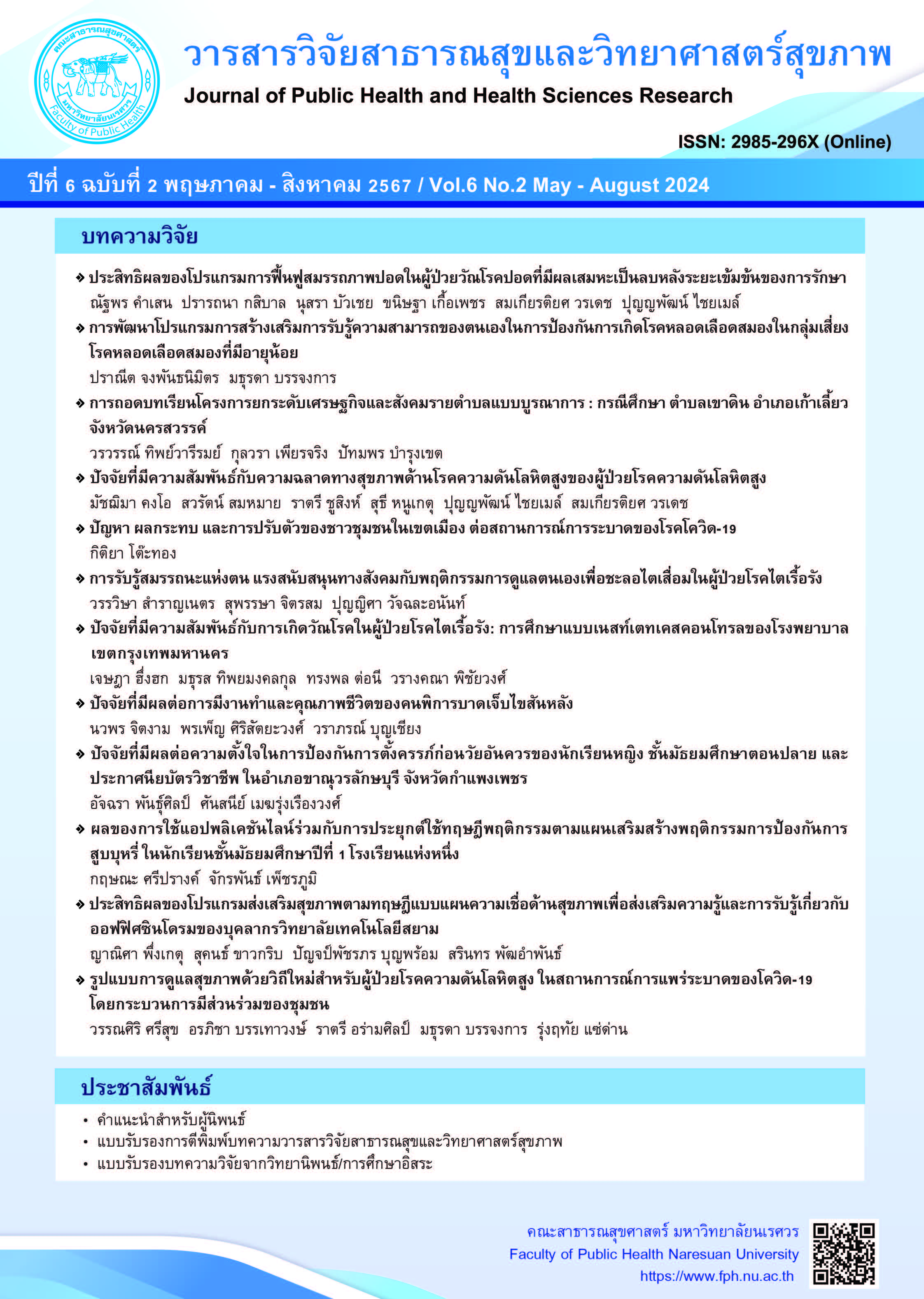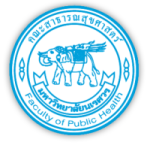A new normal model for hypertensive patients during the COVID-19 outbreak through a community participation process
Keywords:
Community participation, Health behavior, New normal model, Hypertension COVID-19 outbreak situationAbstract
This participatory action research aimed to develop a new normal model for hypertensive patients during the COVID-19 outbreak through a community participation process. The study subjects were 30 hypertensive patients, 3 health personnel working at sub-district health promoting-hospital, and 5 village health volunteers using a 4-steps community participation process: 1) plan 2) act 3) observe and 4) reflect on the results. The study comprised four phases: firstly, understanding the current situation and analyzing associated problems; secondly, devising a comprehensive model; thirdly, implementing and monitoring the new model; and finally, evaluating the outcomes and disseminating the findings to the community. The program spanned six months. This program was implemented for 6 months. Data were collected with a personal information questionnaire, health status assessment form, self-care behavior, and health behavior questionnaires, using the concept of 3S 3E 1N Data was analyzed by descriptive statistics and repeated measure MANOVA.
The results found that the new model of 3S (Suatmon: praying, Samadhi: meditation, Studying Dharma: reading) 3E (Eating, Exercise: Maniwet, Emotional management) and 1N (Normal life clock). Monitoring was utilized in the first 3 months to enhance participants' healthy behavior by using the 3S 3E 1N There was encouragement and follow-up during the first 3 months, encouraging the sample to have health behaviors according to the principles of 3S 3E 1N The average scores of behaviorsregarding 3S 3E 1N was significantly different at the 0.05 level. However, the average scores of general behaviors among patients with hypertension did not differ significantly between the period before the program initiation and six months after its completion. The study indicated the importance of regular supervision and follow-up, preferably at least once a month, to promote consistent behavior.
References
Aekplakorn, W., Puckcharern, H., & Satheannoppakao, W. (2021). The 6th Survey of Thai Public Health by Physical Examination 2019-2020. Bangkok: Auksorn Graphic and Design. (in Thai)
Anti-Corruption Operation Center. (2022). Policy on good health, new way, Dharma way, Thai way, and sufficiency economy, Ministry of Public Health 2021-2027. Retrieved Nov 1, 2022, from http://www.stopcorruption. moph.go.th/index.php/main/p_detail/page/662 (in Thai)
Boonchai,K. (2020). Assessment of damage. Impacts and adaptation of local communities to the epidemic situation of COVID 19. Bangkok: Local Community Development Foundation. (in Thai)
Chusuton, S., Hirunwatthanakul, P., & Glangkarn, S. (2022). Delvelopment of Health Promotion Model among Elderly though Community Participation in Bang Nok Khwaek sub-district Municipality, Bang Khonthi, Samut Songkram. Journal of Allied Health Sciences Suan Sunandha Rajabhat University, 7(1), 40-56. (in Thai)
Division of Non Communicable Diseases. (2019). NCD Statistics. Retrieved Nov 1, 2022, from http://www.thaincd.com/2016/mission/documents-detail.php?id=13684&tid=32&gid=1-020 (in Thai)
Division of Non Communicable Diseases. (2023). NCD Statistics. Retrieved Feb 2, 2023, from http://www.thaincd.com/2016/mission/documents-detail.php?id=14480&tid=32&gid=1-020 (in Thai)
Hanphichai, S., & Julsawat, T.(2021).The Effects of the Epidemic of the Corona Virus-2019: Toward the New-Normal Community in Lop Buri Province. Journal of Roi Kaensarn Academi. 6(9). 126-141. (in Thai)
Office of Health Strategic Management, Thai way of life. (2021). People's Guide Create good health in a new way, Dharma way, Thai way, way of sufficiency economy with the principle of 3S. 3O. 1.N. and meditation therapy SKT. Bangkok: Office of Health Strategic Management. (in Thai)
Prapromma, S. (2020). A Thai Buddhist Ethics Program for changing health behavior among the risk group of chronic disease in a sub-district Health Promotion Hospital, Phukdiechumphol District, Chaiyaphum province. Journal of The Health Education Professional Association, 35(1), 56-68. (in Thai)
Prochaska, J. O., Norcross, J. C., Diclemente, C. C. (2006). Changing for Good. A revolutionary six-stage program for overcoming bad habits and moving your life positively forward. New York: Harper Collins Publishers.
Piyaseth, L. (2016). A Model Development to Enhance Buddhism-Oriented Health Conditions for Preventing and Solving Chronic Illness in the Community: A Case Study of Ban Khui. Parang, Wang Kuang Sub-District, Prankratai District, Kamphaeng Phet Province. Journal of Health Education, 39(132), 23-4. (in Thai)
Sinsap, N., Jankra, J., & Jaiman, B. (2017). Hypertension in Elderly: Silence Killer Should be Aware. Journal of Phrapokklao Nursing College, 28(1), 100-11. (in Thai)
Sudsukh, U., Sathira-Angkura, T., Kladjomphong, P., & Jaigla, B. (2021). Development of good health promotion model that integrated with Buddhist ways for the prevention and control of non-communicable diseases. Foundation Uthai Sudsukh. (in Thai)
Tah-Chang Sub-District Health Promoting Hospital. (2022). The report of COVID-19 patient statistics in Tah-Chang Sub-District Health Promoting Hospital. Chantaburi: Tah-Chang Sub-District Health Promoting Hospital. (in Thai)
Thai Hypertension Society. (2021). Hypertension. Retrieved Nov 1, 2022, from http://www. thaihypertension.org/information.html (in Thai)
Thanirat, T., Ploysup, S., Yaso, T, & Inthong, T. (Ed.). (2017). Guidelines for health care with Dharma principles, Thai way (3Sor. 3Or. 1 pm.) of 5 religions. Nonthaburi: Office of Alternative Medicine, Department of Thai Traditional and Alternative Medicine Development, Uthai Sudsuk Foundation. (in Thai)
Watana, S., & Sinthuvongsanon, D. (2019). Outcome of health behavioral adaptation by the application of Buddhism for the diabetes mellitus risk group age over 35 years old: A case study of Thongchainuea Sub-district, Pakthongchai District, Nakhon Ratchasima Province. Regional Health Promotion Center 9 Journal: The Journal for Health Promotion and Environmental Health, 30(12), 76-91. (in Thai)
Weber, MA., Jamerson, K., Bakris, GL., Weir, MR., Zappe. D., Zhang, D., et al. (2013). Effects of body size and hypertension treatments on cardiovascular event rates: Subanlysis of the ACCOMPLISH randomised controlled trial. Lancet (London, England), 381(9866), 537–545.
Downloads
Published
How to Cite
Issue
Section
License
Copyright (c) 2024 Journal of Public Health and Health Sciences Research

This work is licensed under a Creative Commons Attribution-NonCommercial-NoDerivatives 4.0 International License.
The published article is copyrighted by the Journal of Public Health and Health Sciences Research.
The statements that appear in each article in this academic and research journal are the personal opinions of each author and are not related to Naresuan University and other faculty members in the university. Responsibilities regarding each article are the responsibility of each author.






